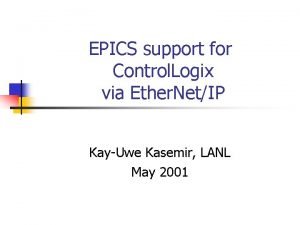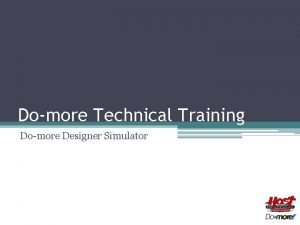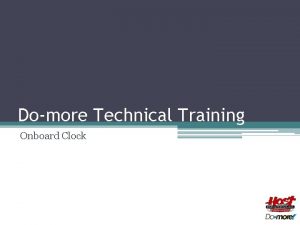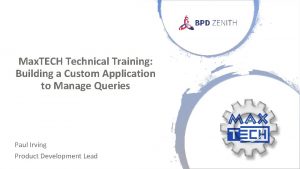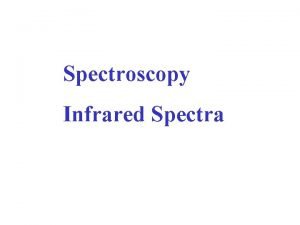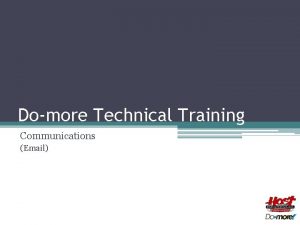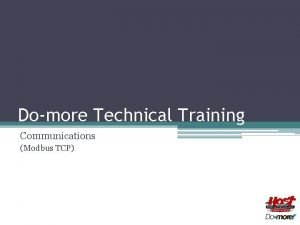Domore Technical Training Communications Ether NetIP Communications Ether







- Slides: 7

Do-more Technical Training Communications (Ether. Net/IP)

Communications – Ether. Net/IP • Ether. Net/IP Explicit Message Server (Slave) ▫ Do-more built-in Ethernet port • Ether. Net/IP Explicit Message Client (Master) ▫ Do-more built-in Ethernet port Client (Master) Server (Slave)

Communications – Ether. Net/IP • Ether. Net/IP Explicit Message Server (Slave) Configure up to 8 Blocks �Ether. Net/IP Explicit Message Server (Slave) must be enabled & ▫ Do-more built-in Ethernet port configured �Use CPU Configuration Ether. Net/IP Explicit Message Server, check the “Enable Ether. Net/IP Server” box Default TCP �Use <Ether. Net/IP Settings…> button to change parameters as Parameters desired �Configuration creates $Int. EIPServer structure with members: These 4 parameters ▫ ▫ Active. Sessions – (unsigned byte) # of concurrent open connections are vitally important Last. Error – (unsigned byte) error code of last failed transaction & must be matched Errors – (unsigned by the Client word) # of failed transactions Transactions – (signed double-word) # of successful transactions �Serves up the Blocks as defined �Can have up to 16 Clients (Masters); default = 4 �Ether. Net/IP uses TCP so TCP session must be established

Communications – Ether. Net/IP • Ether. Net/IP Explicit Message Client (Master) ▫ Do-more built-in Ethernet port �One Ether. Net/IP Explicit Message Client Device (@Int. EIPClient) exists by default �Use Device Configuration to change parameters as desired @Int. EIPClient (Master) @Int. EIPClient @My. EIPClient ▫ Timeout: milliseconds (ms) to wait for Server (Slave) to respond (Master) ▫ Retries: how many times to retry comm ▫ Inactivity Timeout: seconds to keep TCP connection alive due to inactivity (no EIPMSG being executed) before doing a TCP disconnect from the Server (Slave) Server �Use EIPMSG instruction Server (Slave) #1 �Multiple EIPMSG instructions can be used to same Server (Slave) (Master) Server (Slave) #2 �If >1 Server (Slave), it is more efficient to create an Ether. Net/IP Explicit Message Client Device for each one (see Modbus TCP slides for the detailed reason why)

Communications – Ether. Net/IP • EIPMSG “Send Ether. Net/IP Message” ▫ Reads/writes data from/to an Ether. Net/IP Explicit Message Server (Slave) ▫ Fully asynchronous instruction ▫ Parameters: � Device – Ether. Net/IP Explicit Message Client Device name � IP Address – Fixed or Variable; TCP Port (44818 default) � Path – Class, Instance, Attribute � Service � Specific Service: ▫ Get Attribute (14, 0 x 0 E) – read ▫ Set Attribute (16, 0 x 10) – write ▫ Get ALL Attributes (1, 0 x 01) – read ▫ Set ALL Attributes (2, 0 x 02) – write � Generic Service: any other service not named above � Enable – (self explanatory) � On Success/On Error – (ditto) � Use Request Service Data Buffer – gets selected automatically if setting an attribute (writing); length must match � Use Response Service Data Buffer – gets selected automatically if getting an attribute (reading) � Generic Status Code – this is defined by the Ether. Net/IP server’s documentation � Extended Status – use this if necessary

Communications – Ether. Net/IP Client (Master) Do-more CPU EIPMSG @Int. EIPClient Ether. Net/IP Server (Slave) Do-more CPU @Int. EIPServer Blocks 1 -8

Communications – Ether. Net/IP • Define Block 1 in Do-more CPU • Define Block 1 in SIM on your PC • Use EIPMSG instruction in CPU to write to SIM • Use EIPMSG instruction in CPU to read from SIM • Use EIPMSG instruction in SIM to write to CPU • Use EIPMSG instruction in SIM to read from CPU Do-more 10. 1. 1. 110 SIM 10. 1. 1. 200 EIPMSG N 10 Block 1 EIPMSG D 10 Block 1
